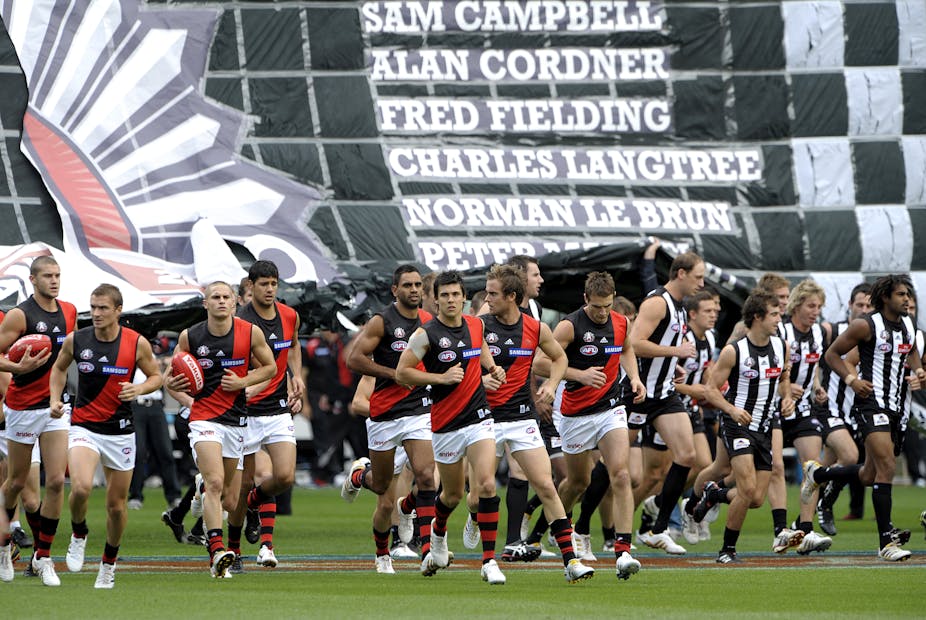The Anzac Day clash between Essendon and Collingwood has come and gone yet again, as well as the inevitable publicity surrounding the most hyped home-and-away match of the season.
You could be forgiven for thinking that it was worth 12 premiership points as opposed to the usual four.
A fresh (subtly economic) talking point was raised last week, with Kevin Sheedy and Michael Malthouse both contributing to the discussion on whether these two clubs should continue to be given a monopoly over Anzac Day.
On this note, it is rational to go even further and reflect on the broader issues and consequences of guaranteed scheduling of matches between the triumvirate of Melbourne’s privileged clubs – Carlton, Collingwood and Essendon, twice per season.
Beginning with Carlton and Collingwood in 1991 and extending to Essendon in 1993, the “cartel” had this practice enshrined, since their own attendances would rise (as they were playing other big-market sides more often than average).
It also increased the likelihood that those games would be shown free-to-air in Melbourne, and a larger share of the exposure pie.
The league’s reasoning for this practice is that it helps maximise overall league attendances and interest, and so this has been thus far in 2011 (as expected, since all three teams are near the summit of the table).
The same argument applies to matches between other local rivals, mainly the two Adelaide teams and the two Perth teams.
However, the problem with the Melbourne blockbusters specifically is the equity issue – Melbourne’s smaller-market teams (the other local rivals) get to play these financially lucrative games against the big three less often.
It is well known that these smaller clubs include a home game (home side keeps the gate revenue) against Collingwood systematically on their fixture ‘wish-list’.
As an example of the inequities caused by this system, in the years from 1997-2010, Carlton and Essendon have each played Collingwood the maximum 28 times, while Geelong and North Melbourne have each played Collingwood on only 16 occasions. In compensation for this, a blockbuster levy of $25,000 was imposed on the big three.
While the status quo is a bone of contention to many fans of the remaining Victorian clubs, the issue has not yet come to a head.
However, expansion to 18 teams next year is going to have implications for the season design. With a 22-round season, each team will play five teams twice, compared to seven previously, making it harder to justify the blockbuster guarantee under the expanded competition, even with a greatly increased levy.
Furthermore, the demand effects also need to be considered. US economist Michael Butler at Texas Christian University found, using Major League Baseball data, that there was a 7% increase in match attendances (accounting for all other factors) involving pairings of teams that had played each other less often in past seasons – that is to say fans become tired of seeing their team play any other team too frequently.
Some recent statistical models we have estimated using AFL data have produced results that indicate there is no such thing as a blockbuster ‘premium’. In other words, the big three draw large attendances to games between themselves purely because they are playing another team with a large fan-base.
However, scheduling the previous season’s Grand Finalists twice produces a significant premium (and presumably they are different teams over time), raising questions about why this pairing is not guaranteed. We also identify other improved scheduling strategies.
While there is much less reason to stop scheduling the Perth “derbies” and Adelaide “showdowns” twice (there is no economic desire for other teams to play these teams more often), the results are suggesting that the blockbuster should be reconsidered.
Rescinding the practice would also have other desirable effects, such as freeing up some of the restrictions placed on the fixture generally – these restrictions forced the league to abandon the week 1-15 full round-robin in 2008. This alteration has since created numerous anomalies that have proved to be deeply unpopular with many fans.
To soothe Anzac Day advocates, this game can still be considered sacrosanct – just in some years, it would also be the final time Collingwood and Essendon meet for the season.
Since the simplest solution of extending the season to two round-robins is impractical for many reasons, this issue has to be addressed explicitly.

